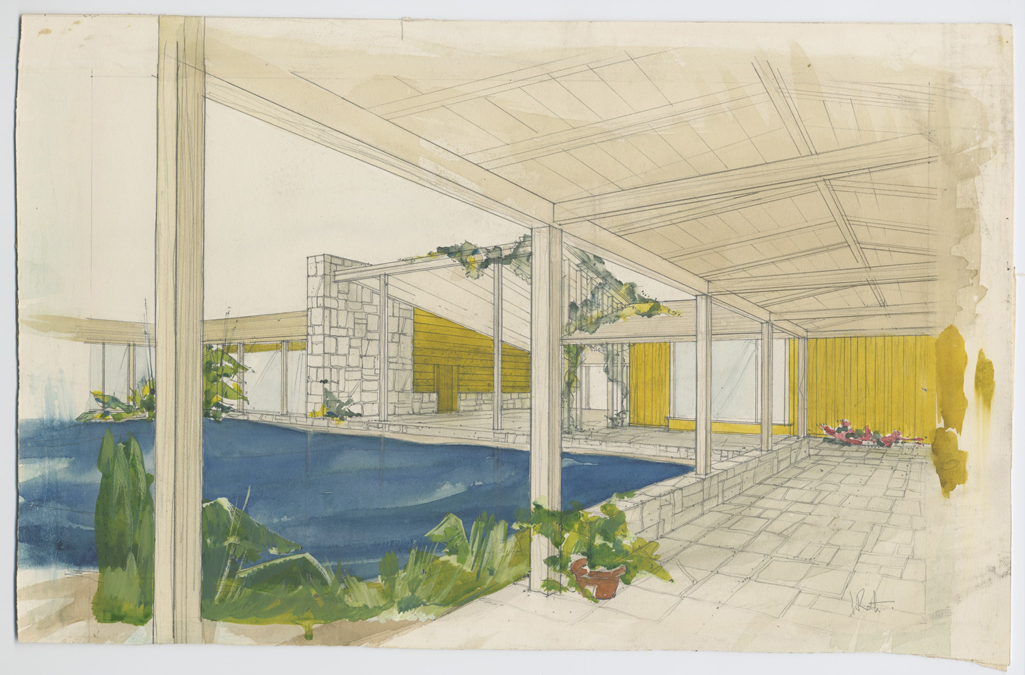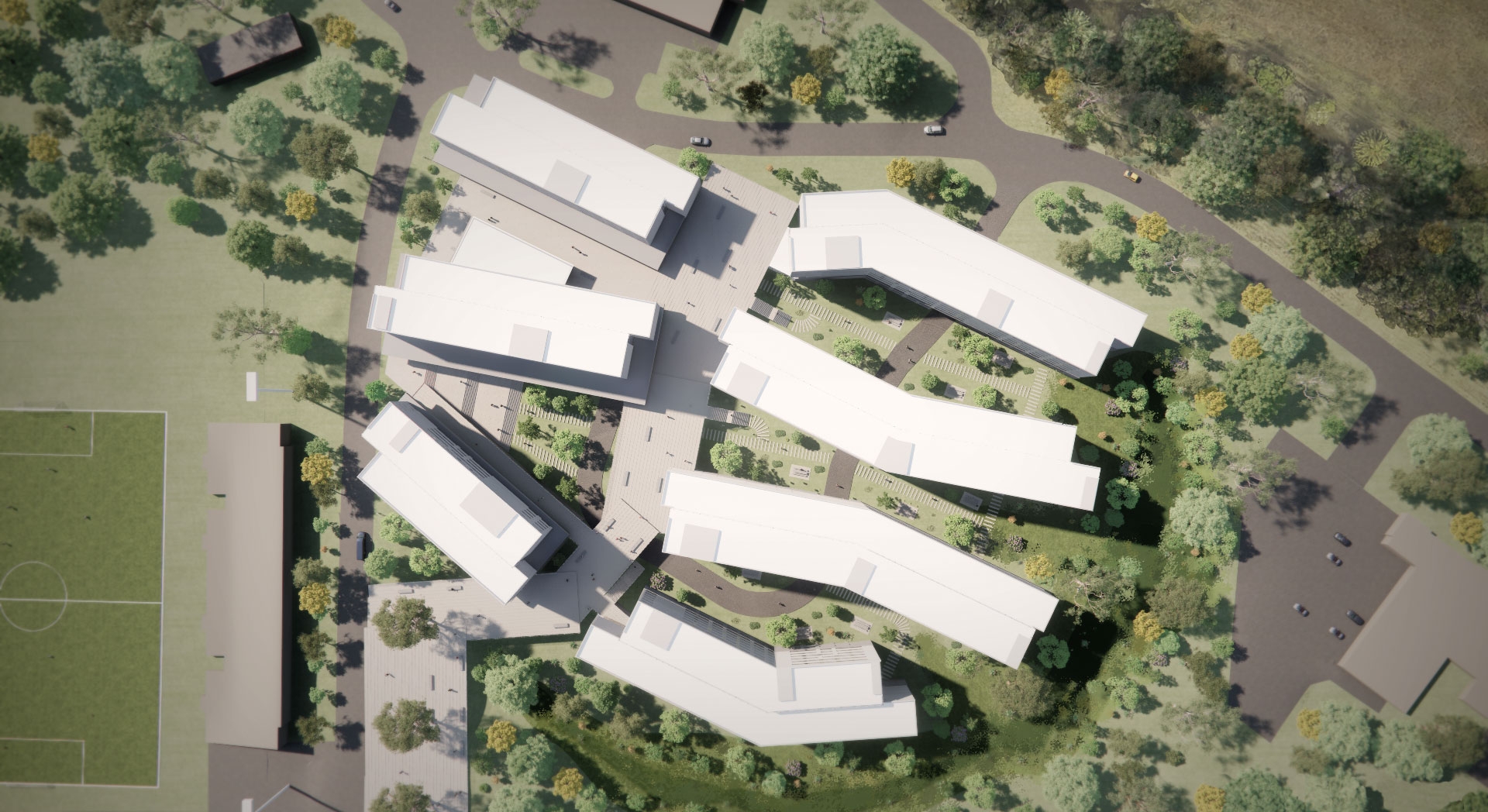
Art, Design & Architecture Museum at UCSB Features 'Carefree California: Cliff May and the Romance of the Ranch House' and Catherine Opie Photos of Cliff May Houses
The Art, Design & Architecture Museum at UC Santa Barbara presents "Carefree California: Cliff May and the Romance of the Ranch House," the first major retrospective of the designer who popularized the ranch house and made it an icon of casual California living in the post-war era. "Carefree California" is curated by Jocelyn Gibbs and Nicholas Olsberg, and opens Feb. 26, 2012. It is part of Pacific Standard Time, an unprecedented collaboration, initiated by the Getty, which brings together more than 60 cultural institutions from across Southern California to tell the story of the birth of the Los Angeles art scene.
In conjunction with "Carefree California," the UCSB museum has commissioned noted contemporary artist Catherine Opie to document a selection of Cliff May houses in Southern California. Her photographs of a May tract house in Long Beach and a custom house in the Brentwood neighborhood of Los Angeles will be exhibited simultaneously with "Carefree California," lending a contemporary perspective from a photographer who has a history of exploring notions of community, identity, and urban space through portraits and landscapes. The exhibit, "Catherine Opie Photographs Cliff May," is organized by Elyse A. Gonzales.
"Carefree California explores the phenomenal rise of the ranch house, casual living, and the western mystique, as promoted by Cliff May, the designer of thousands of modern California ranch houses," says Bruce Robertson, art historian, professor, and acting director of the Art, Design & Architecture Museum. The exhibition looks at how this house type emerged, the context in which it was developed, and the ways in which the ranch house idea reached different classes, needs, and regions. Opie's photographs illustrate the continued relevance of May's pioneering designs.
"Catherine Opie was ideal for this commission because of both her admiration for May's designs and her famed portraits and landscapes that investigate the contemporary American social landscape, especially as it relates to particularized communities of individuals and urban/suburban planning," adds Robertson.
The Carefree California exhibition and accompanying catalog examine the modernization of the ranch tradition and its transition from regional designs in adobe, brick, tile, and stucco to the modest wood and glass tract house of the 1940's, to the near-minimal, system-built ranches May designed and sold in the late 1950's, and, finally, to his luxury ranch houses. Carefree California is based on the Cliff May archive and also draws upon the archives of more than 20 additional California architects, all part of the Museum's Architecture and Design Collection.
Through drawings, models, sales pamphlets, photographs, site maps, publications, film and television clips, and popular magazines, the exhibition will address the opening up of the plan, the emphasis on patio and glass corridor to suggest additional space, and the integration of house and garden. It will explore wartime industry, postwar in-migration, and the federal subsistence and military building programs that set many of the material terms and language for postwar tracts and for May's ubiquitous Californian solution that helped create an important regional identity.
May did not invent the ranch house but he was the most influential popularizer of the ranch house style. May's essential message –– the romance of the rancho married to modern informal living –– never changed and can be seen in his earliest houses in San Diego, the urban ranch houses he designed for Riviera Ranch in the Brentwood hills, and in his low cost prefabricated Cliff May Homes, designed with architect Chris Choate and built throughout California and across the country. May's work was promoted by Sunset Magazine, House Beautiful, House and Garden, Good Housekeeping, Arts and Architecture, and many other popular magazines.
Two books, "Sunset Western Ranch Houses" (1946) and "Western Ranch Houses by Cliff May" (1958), explained the allure of ranch house-living through examples of May's work. In all, May designed about 1,000 buildings, and his house plans were used by developers to build nearly 18,000 tract houses.
Opie's 15 color photographs provide surprisingly intimate details of three May houses, proving May's belief that the ranch house was the perfect form for casual but gracious California living, no matter the size of the house. Opie has photographed living spaces, exteriors, windows and reflections, still lifes, and two current homeowners. One of the houses is a "low-cost" 1950's Cliff May Home in the Lakewood Rancho development in Long Beach. The other, from about the same time, is a custom home in the Riviera Ranch development in Brentwood, now owned by actor Ed O'Neill ("Modern Family"). To complement these images, Opie has included an earlier photograph of Amy Pascal, co-chairman of Sony Pictures Entertainment, in her May ranch house.
"Carefree California" and "Catherine Opie Photographs Cliff May" will run from February 26 to June 17, 2012, with an opening reception for the public at 1p.m., Sunday, February 26.
The Art, Design & Architecture Museum is open Wednesday-Sunday, noon–5 p.m. Admission is free. For directions, please visit www.museum.ucsb.edu.
About Pacific Standard Time: Art in LA 1945 – 1980
Pacific Standard Time is a collaboration of more than 60 cultural institutions across Southern California, coming together for six months beginning in October 2011 to tell the story of the birth of the Los Angeles art scene and how it became a major new force in the art world. Each institution will make its own contribution to this grand-scale story of artistic innovation and social change, told through a multitude of simultaneous exhibitions and programs. Pacific Standard Time is an initiative of the Getty. The presenting sponsor is Bank of America.
About the Art, Design & Architecture Museum
The Art, Design & Architecture Museum (formerly the University Art Museum) at UC Santa Barbara holds a Fine Art Collection (photographs, prints, paintings, and sculpture) and engages contemporary artists in exhibits and programs. The Museum's Architecture and Design Collection (ADC) is one of the largest architectural archives in North America, and includes drawings, photographs, manuscripts, and furniture by architects and designers. Established in 1963 by UC Santa Barbara professor David Gebhard (1927-1996), the ADC holds more than 255 collections and comprises more than 1 million drawings, 200,000 photographs and negatives, and 1600 linear feet of manuscript materials that reflect the diversity of California's designed and built heritage.
† Top image: Cliff May, House Beautiful demonstration home, Woodacres (Los Angeles, Calif.):
patio perspective, circa 1945
pencil and watercolor on board: 10 1/2 x 16 1/2 in.
(Cliff May Papers)
†† Middle image: Cliff May, Cliff May, Gerald Katell house (Rolling Hills, Calif.):
bird's eye perspective of preliminary design, 1978
Rendering by Jamison
watercolor on board: 22 3/4 x 35 in.
(Cliff May Papers)
††† Bottom image: Catherine Opie, Old Ranch Road #4, 2011, 20 x 26.5 in., inkjet print
Courtesy Regen Projects, Los Angeles © Catherine Opie
Related Links



